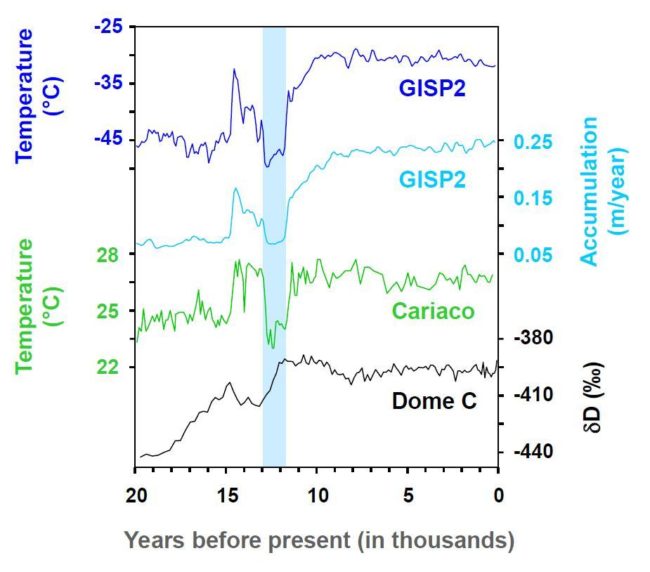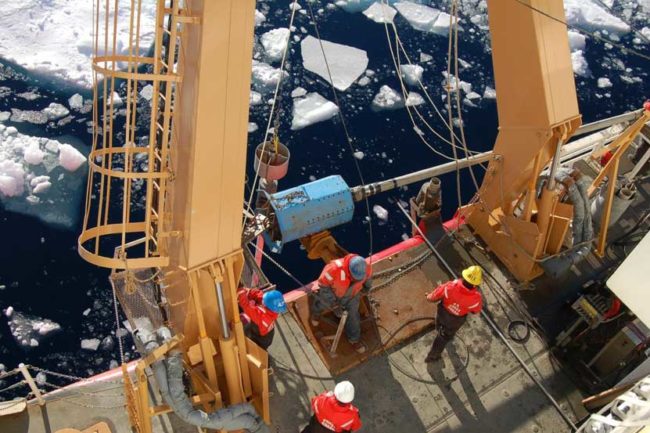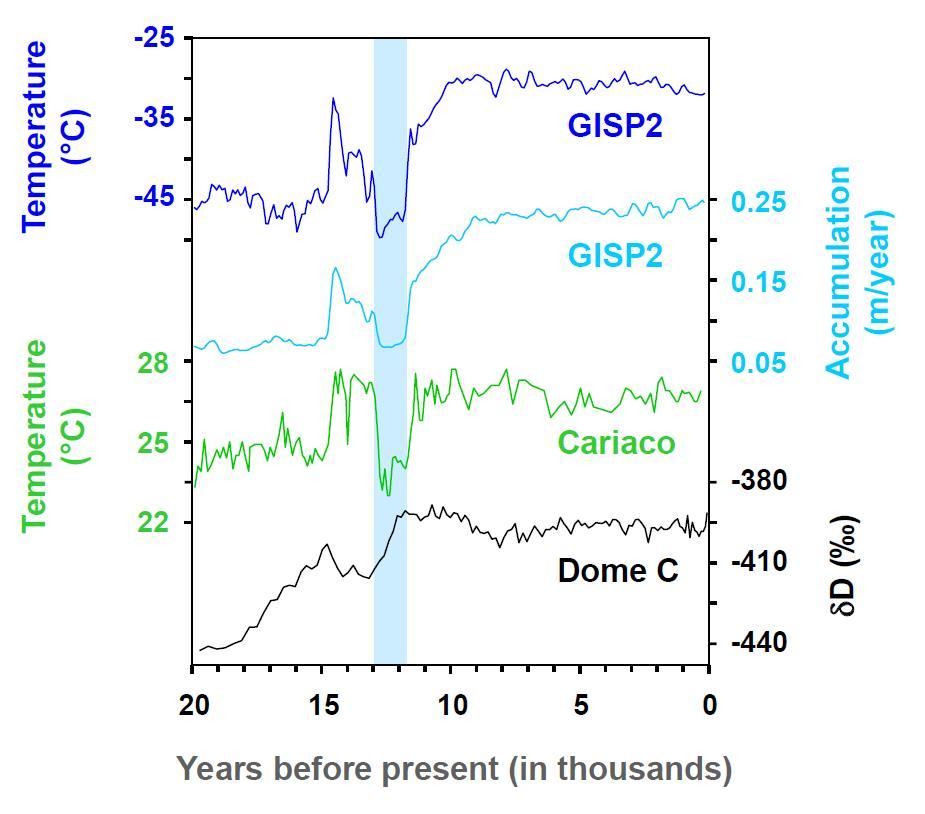About 14,500 years ago as we began to move out of a cold glacial period and back into a warmer interglacial something mysterious happened. That warming suddenly stopped and we shifted back into a cold glacial climate in the northern half of the planet. In about 11,500 this pause ended and things very abruptly shifted back into the on-going warming phase.
This event is referred to as the Younger Dryas.
It has been known about for some time and can be seen and measured within many paleoclimate reconstructions from many different places. For example …

Note in the above you can see it happened in the Northern Hemisphere. Dome C in the above is ice core data from the Antarctic that shows a warming and so it has no evidence of this cooling in that same period.
The “Younger Dryas” is a Weird name for this event

There is an alpine–tundra wildflower named Dryas octopetala that grows in cold climates. We know about these cooling event because we find Dryas pollen within lake sediments that date to that time, hence the cooling event is named after these …
Since 1916 and the onset and then the refinement of pollen analytical techniques and a steadily-growing number of pollen diagrams, palynologists have concluded that the Younger Dryas was a distinct period of vegetational change in large parts of Europe during which vegetation of a warmer climate was replaced by that of a generally-cold climate, a glacial plant succession that often contained Dryas octopetala. The drastic change in vegetation is typically interpreted to be an effect of a sudden decrease in (annual) temperature, unfavorable for the forest vegetation that had been spreading northward rapidly.
But why “Younger”?
Well because there were several of these events, and so the most recent one is known as the younger dryas.
Why did it happen?
There is much debate about the precise cause.
The prevailing thinking is that the North Atlantic “Conveyor” current, sometimes referred to as the Gulf Stream, either greatly slowed or even shut down. This is an ocean current that pumps warm gulf water northwards and if that suddenly slows or stops you get this abrupt cooling event.
But why did that ocean current change happen?
Several ideas include …
- An impact event
- An eruption event
… but the evidence for either of these is not robust.
We may in fact now have an answer because a new study has just been published.
Titled “Deglacial floods in the Beaufort Sea preceded Younger Dryas cooling” and published within Nature geoscience on 9th July, it lays out some new evidence as follows …
Known as the Younger Dryas (YD), the event is thought to have resulted from a slowdown of the Atlantic meridional overturning circulation in response to a sudden flood of Laurentide Ice Sheet meltwater that reached the Nordic Seas. Oxygen isotope evidence for a local source of meltwater to the open western North Atlantic from the Gulf of St Lawrence has been lacking. Here we report that the eastern Beaufort Sea contains the long-sought signal of 18O-depleted water. Beginning at ~12.94 ± 0.15 thousand years ago, oxygen isotopes in the planktonic foraminifera from two sediment cores as well as sediment and seismic data indicate a flood of meltwater, ice and sediment to the Arctic via the Mackenzie River that lasted about 700 years. The minimum in the oxygen isotope ratios lasted ~130 years. We suggest that the floodwater travelled north along the Canadian Archipelago and then through the Fram Strait to the Nordic Seas, where freshening and freezing near sites of deep-water formation would have suppressed convection and caused the YD cooling by reducing the meridional overturning.
In other words, as the vast ice sheets on the North American continent melted and collected in vast lakes, there was a flood of this freshwater over a 700 year period into the Arctic and then on out into the Atlantic. This is what disrupted the “meridional overturning”, or to use the more familiar term, disrupted the gulf stream that had been transporting heat from the equator northwards.
Is this a done deal?

It is part of the ongoing debate. Others still argue for a flood event via a different route, that had the same outcome.
What this study brings to the table is evidence from core samples for one specific route.
While the precise route is debated, both agree that vast amounts of freshwater ended up disrupting ocean circulation.
What does this mean for us?
Sitting in Greenland is a vast reservoir of frozen freshwater. In a warming world that gives us an ever increasing flow of meltwater then that could once again potentially disrupt the ocean circulation. It would not be on the same scale as that ancient flood because it is simply not as large a source, and yet looking back we can potentially learn about what may yet come.
The deep irony is that global warming could lead to cooling in some regions, and yet longer term the global warming might in turn offset that and even overtake it.
There is existing evidence that the Atlantic circulation has already weakened and that this is ongoing …
Two new and quite independent studies have been published in Nature with some rather dire news concerning a slowdown of ocean circulation due to climate change.
Both concern the Atlantic meridional overturning circulation (AMOC) that is perhaps better known as a Gulf Stream.
The first provides direct evidence that it has slowed down by 15% since the mid twentieth century. The second provides evidence that it is now weaker than at any other time over the past 1,500 years
Should we be worried?
Basically yes, and more than a little bit of worry is wholly appropriate. The evidence merits it.
Further Reading
- NOAA explains the Younger Dryas
- The Younger Dryas Wikipedia Page
- Chris Mooney discusses this latest study within the Washington Post
- The new study is available in Nature Geoscience.

Many professors and scientists plead for one ore the other theory,, why suddenly this climate change happened.. But nobody explains why the climate changed back after about 1000 years also very suddenly. An impact cannot be canceled and the Gulfstream notbe warmed up suddenly . So, all these theories are not valid. What do you think about a short moving of the earth -axle?Do I get a University-seat or nbel-prize for this Idea.
?
Data is data, now we need to explain it.
If you present a testable hypotheses that explains the data, and then perform the test, and write it up, and spend a lifetime working on it, and your colleagues recognise the contribution you have made … then you win something.
Not Nobel. It has no geology award.
It may be possible that the Gulf Stream gets overturning.. But the influence of the Gulf Stream is limited. It warms up Western and Middle Europe but not Russia and Sibiria and not Northern Amerika. But the Mammuts – and other big mammals in Northern Eurasia and the Mastodons in Northern Amerika starved and died out because the photosynthesis stopped working because of a huge cloud of dust.All that ist not possible by a collapse of the Gulf Stream. In Middle Russia and Sibiria is no more Influence of the Gulf Stream. And what about Mastodons in Northern Amerika? How can the water of the St. Lawrence river infuence their lives?